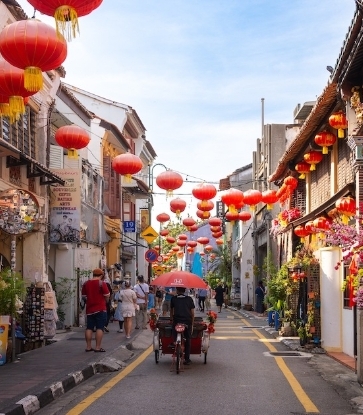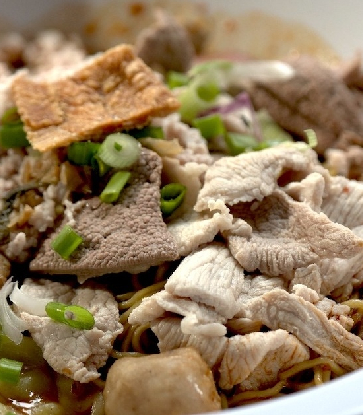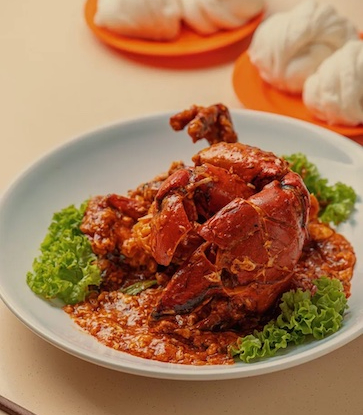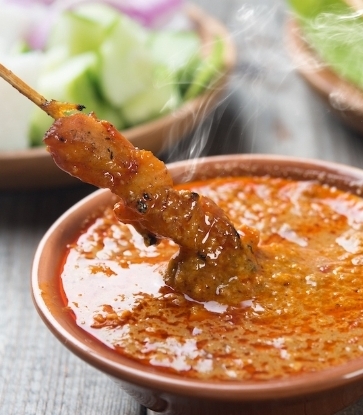Buah Kulim, or jungle garlic, is the current talk of the town in Malaysia’s ever-evolving but always exciting dining landscape.
The odoriferous stinkin’ rose of the tropical rainforest is the belle du jour, where the nation’s top chefs are concerned — anointing their salads, meats, breads, and other culinary creations with oil steeped in Buah Kulim.
So, what is Buah Kulim, and since when has it become so popular and so much sought-after?
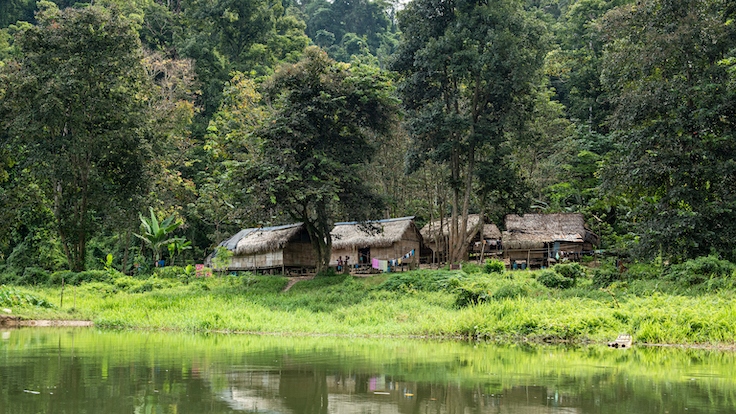
The first people known to utilise Buah Kulim are the Orang Asli (“First People”) of the Malay Peninsula. Prolific hunter-gatherers, these nomadic indigenous tribes traverse deep into the 130-million-year-old tropical rainforest.
Fun fact — Victorian era botanist, Henry Nicholas Ridley, the founding director of the Singapore Botanic Gardens and often called the “Father of the rubber industry in Malaya”, had first mentioned the plant in his paper entitled Malay Materia Medica (Published in 1897) under the local name “kulim”, and described it as “a large tree every part of which smells strongly of onions”. Its fruit — the Buah Kulim itself — is a yellow-brown, hard-shelled walnut-sized fruit which, when cooked, yields a deep, strong umami flavour.

The person credited with popularising the erstwhile little-known Buah Kulim to the general Malaysian public — and pioneered its use commercially — is the cerebral and meticulous Darren Teoh, whose trailblazing 2 MICHELIN Star restaurant, Dewakan, is renowned for its daring, innovative use of native products for its exciting takes on contemporary modern-Malaysian cuisine.
It all started with a jungle trek eight years ago, which took him deep into the Amazonian-like jungles of Endau-Rompin National Park in the Malaysian state of Pahang. Their guide along the arduous trail was a tribal elder (or batin) of the local Jakun aboriginal tribe, a sub-group of the Semang, the earliest inhabitants of the land, dating back some 25,000 years.
The Jakun lead a nomadic, hunter-gatherer lifestyle, and they are voracious foragers who are adept at identifying and adapting the various species of flora and fauna for daily use.
Teoh remembers a point during their trek when he encountered a heavy pungent scent that hung in the air. He had asked the batin what gave out that smell and was that it came from the Buah Kulim tree that they were passing. Teoh was amazed when he was shown the bark and leaves of the tree, which contained the smell.
The Jakun are among the first people to utilise the Buah Kulim, recognising the plant’s potential for seasoning food in the absence of onions or garlic. They chose to call it "Jungle Garlic", although the Buah Kulim has a deeper, stronger flavour profile than garlic itself. The tribe also believes in the medicinal properties of Buah Kulim, which Teoh described as “almost Ayurvedic in its approach”, preferring prevention rather than cure.
Back at the Jakun tribal village during his initial visit, Teoh was given a taste of food prepared using foraged jungle products, and he was particularly taken in by a meat dish cooked in a sealed bamboo tube and flavoured with seven types of jungle herbs and aromatics — including the shoots of the Buah Kulim. It was off-season for the fruit itself then, so Teoh did not get to see it on that occasion.
However, finally, Teoh encountered the Buah Kulim fruit itself two years later at a marketplace in Bidor, Perak state. There, again, the main users are Orang Asli, this time from the Semai tribe. Teoh took all 40kg of the Buah Kulim off the demure, docile Semai vendors there, and proceeded to experiment with the product.
He learned from the Orang Asli that fresh cracked-open Buah Kulim yields nut-meat, which is usually sliced and boiled, to be used as a flavouring component for meat and vegetable soups or stews. Whenever there are excess Buah Kulim gathered, the kernels would be cut, sun-dried, and usually pulverised into a powder, to be stored and used as a condiment the whole year round.
“The use of native produce poses two unique propositions. First, it allows the restaurant to have the opportunity to discover a world of unknown ingredients and share this unique experience with others. Second, it contributes to creating value within an entire economy of ingredients that thrive in our own backyard — we believe that there is an ecological value to that.”
Nowadays, Teoh is the veritable “Buah Kulim evangelist”, propounding its positive culinary attributes to all. It’s also one of the three “local products” he likes to present to his guests, associates and fellow chefs as corporate gifts, besides East Malaysian rice from Langit Collective, and chocolates from Chocolate Concierge.
Teoh opines, “Malaysians are fond of allocating food items into different ethnic categories: Malay, Chinese, Indian, and more; but they always forget to include the oldest of them all — the cuisine of the indigenous people, the Orang Asli.”
Teoh believes in the vast, untapped potential of jungle herbs and plants found in Malaysia’s tropical rainforests, which can be adapted into the modern-day cooking of the nation.

Buah Kulim’s versatility ties in with Teoh’s approach with regards to the use of local ingredients in his cooking, with an emphasis on sustainability. Teoh was an unabashed champion of delving into the centuries-old knowledge of the Orang Asli in utilising indigenous plant species and herbs for culinary purposes.
Over at Dewakan this season, Buah Kulim figures in two of the dishes on its dégustation menu:
Venison, where thinly-sliced aged venison are marinated in a dressing that includes keranji (tamarind-plum), venison garum, and Buah Kulim-infused oil. It is served with a variety of wild greens.
Pigeon is roasted in a Josper oven, and hen dusted with lacto-fermented onion and Buah Kulim powder. It is served with Adan rice cooked in a clay pot and mixed with spiced clam butter. The condiments accompanying the dish consist of chrysanthemum radish, emperor vegetables compressed with mussel stock and charcoal oil, candlenut tofu with Buah Kulim-infused oil, pickled Losun (wild shallot), pumpkin miso, fermented guava and a mackerel fish paste, and a heart of palm naruto.

Wong’s philosophy sees him personally vetting every single potential product for its maximum usability and minimal wastage, before its inclusion into his pantry of ingredients. Being introduced to Buah Kulim by Darren Teoh, Wong has since been one of the jungle garlic's most ardent advocates.
Gēn’s current menu features Buah Kulim, Mantis Prawn, Lotus Root (pictured on the lower right), which has grilled mantis prawn, accompanied by crispy braised lotus root and lotus seeds, under a blanket of nasturtium leaves, dotted with lemon gel. The sauce is a beguiling combination of braised mussels and chicken stock emulsion, scented with Buah Kulim-infused oil.

"Buah Kulim is a very pungent and intense ingredient. Like how we treat all other ingredients here, we try to repurpose it by vetting through the produce, to see how every single one of its components can be implemented or utilised, before developing dishes using it. Buah Kulim is one of our favourite produce," says Wong.
To Farm or Not to Farm
Buah Kulim grows wild in the jungle — there have been no concerted efforts as yet to cultivate it commercially. Its relative rarity (with a heavy reliance on a tiny number of Orang Asli foragers), plus its versatility and vast culinary potential, inevitably draws comparison with Europe’s truffles.
Cultivation of Buah Kulim on a commercial scale holds great promise: its hardwood timber tree only requires well-drained soil for growth, and it germinates after 36 months. It doesn’t have the notoriety nor unpredictability of truffles — fungi that grow underground under exacting conditions, and which require its spores to inoculate specific species of tree roots.
Buah Kulim plantations, with farm workers — Orang Asli or otherwise — for mass cultivation and harvesting is a distinct possibility. Truffle-gathering, on the other hand, has always been a challenge — traditionally, pigs are used to detect wild truffles which grow underground. Due to the commodity’s high value, truffle hunters vie with each other to find the areas where truffles can be found. Subsequently, dogs are trained for this task, as they are considerably less conspicuous when taken out for a spot of truffle-hunting than a pig on a leash.
So, Buah Kulim wins hands-down here; however, the question remains: is the world ready for the more sustainable, environment-friendly Buah Kulim? As Jean Anthelme Brillat-Savarin said, "Tell me what you eat, and I will tell you what you are."
Where to get a taste of Buah Kulim in Kuala Lumpur & Penang:
Dewakan (Two MICHELIN Stars, MICHELIN Guide Kuala Lumpur & Penang 2024)
Beta (One MICHELIN Star, MICHELIN Guide Kuala Lumpur & Penang 2024)
Communal Table by Gēn (Bib Gourmand, MICHELIN Guide Kuala Lumpur & Penang 2024)
Akâr (Selected, MICHELIN Guide Kuala Lumpur & Penang 2024)
Gēn (Selected, MICHELIN Guide Kuala Lumpur & Penang 2024)







